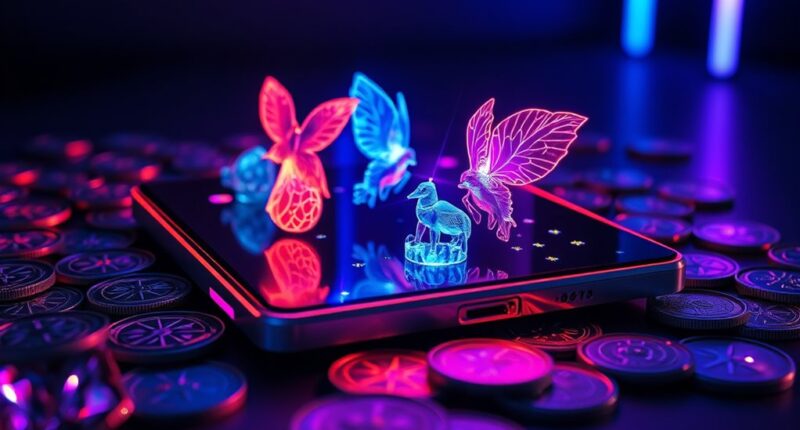NFTs are digital collectibles that turn digital files into unique, verifiable assets secured by blockchain technology. When you buy an NFT, you gain ownership of a one-of-a-kind digital item like art, music, or virtual collectibles, recorded on a decentralized ledger. This confirms its authenticity and prevents duplication or tampering. Understanding how NFTs create secure, transparent ownership helps you see their potential in digital content. Keep exploring to learn more about how NFTs are changing digital ownership.
Key Takeaways
- NFTs turn digital files into unique, verifiable collectibles secured on a blockchain.
- Buying an NFT grants ownership rights, verified through an immutable, transparent ledger.
- NFTs serve as digital certificates, proving authenticity and provenance of digital assets.
- They enable secure, tamper-proof transactions for digital art, music, and virtual collectibles.
- Blockchain’s decentralization ensures no single entity can alter or revoke NFT ownership.

NFTs have revolutionized the way we think about digital ownership, turning digital files into unique, verifiable collectibles. When you buy an NFT, you’re acquiring a digital asset that’s secured through blockchain verification, guaranteeing it’s one-of-a-kind and impossible to duplicate. Unlike traditional digital files—such as images, music, or videos—NFTs establish clear ownership rights that are recorded on a blockchain, a decentralized ledger. This technology guarantees the authenticity and provenance of your digital collectible, making it more than just a file you can copy and share. Instead, it becomes a verified piece of digital property that you truly own.
Understanding how blockchain verification plays a vital role helps you grasp why NFTs are so valuable. When you purchase an NFT, the transaction is recorded on the blockchain, which acts as an immutable record. This means that once your ownership is registered, it can’t be altered or erased by anyone, not even the creator. This transparency and security give you confidence that your digital collectible is genuine and uniquely yours. The blockchain also tracks the entire history of the NFT—who created it, who has owned it, and any sales or transfers—adding layers of provenance that enhance its authenticity. This level of verification is what distinguishes NFTs from simple digital files stored on your device or cloud.
As a newcomer, you might wonder how this process works practically. When you buy an NFT, you’re not just downloading a file; you’re purchasing a token that points to a digital asset stored on a blockchain network. This token acts as a certificate of ownership, proving that you hold the original version. Because blockchain verification is decentralized, no single entity controls or can manipulate this record, which reassures you about the integrity of your purchase. Whether you’re investing in digital art, music, or virtual collectibles, blockchain verification guarantees your digital ownership is both secure and transparent.
Additionally, the decentralized nature of blockchain technology means that no single authority has control over your digital assets, further enhancing security and trust.
In essence, NFTs leverage blockchain technology to redefine what it means to own digital content. By transforming digital files into verifiable, unique assets, they open up new possibilities for creators and collectors alike. You’re not just copying or sharing files anymore; you’re establishing a secure, authenticated ownership that’s recorded on a blockchain, making your digital collectible truly yours. This innovative approach offers a new level of trust, security, and authenticity in the digital world, giving you confidence in your investments and collectibles.
Frequently Asked Questions
Can NFTS Be Stolen or Hacked?
Yes, NFTs can be stolen or hacked. You face hacking risks if you don’t secure your digital wallet properly, which could lead to digital theft of your NFTs. Be cautious about phishing scams and use strong, unique passwords. Keep your private keys private and consider using hardware wallets for added security. Staying vigilant helps protect your digital collectibles from theft and hacking threats.
Are NFTS Environmentally Sustainable?
Imagine you’re buying an NFT, but it’s created on a blockchain with a high carbon footprint, like Ethereum’s proof-of-work system. The environmental impact is significant, as it consumes massive energy, raising concerns about sustainability. Many experts argue that NFTs aren’t environmentally sustainable due to their high energy use and larger carbon footprint. To reduce this impact, some platforms are shifting toward eco-friendly, proof-of-stake blockchains, making NFTs more sustainable.
How Do NFT Royalties Work?
When you sell an NFT on an NFT marketplace, royalties automatically pay you a percentage of each future sale. This works because smart contracts embed royalty info, ensuring digital provenance and ongoing earnings. You set your desired royalty rate during minting, and every time the NFT resells, the contract enforces the payment. This system creates a sustainable income stream, making NFTs a unique way to earn from your digital collectibles.
Can I Convert NFTS Into Physical Objects?
Yes, you can convert NFTs into physical objects by leveraging digital ownership and physical integration. You might print your NFT artwork on canvas, create custom merchandise, or use 3D printing for sculptures. While the NFT remains a digital asset, the physical item is a tangible representation of your digital ownership. Just guarantee clear links between the digital NFT and the physical object to maintain authenticity and value.
What Are the Legal Rights Associated With Owning an NFT?
When you own an NFT, you generally hold ownership rights to the digital asset, but it doesn’t automatically include intellectual property rights. You might have license or usage rights, but the original creator retains copyright unless explicitly transferred. So, always check the NFT’s terms to understand the legal rights involved, especially regarding how you can use, display, or modify the digital collectible.
Conclusion
So, now that you’ve revealed the secret world of NFTs as digital collectibles, go ahead—dive in and start collecting. Who knows? Maybe someday your pixelated cat will be worth more than your car, and you’ll brag about owning the rarest meme. Just remember, in this wild digital jungle, the true treasure might just be the bragging rights—and a good laugh when your “investment” becomes yesterday’s meme. Happy collecting!









